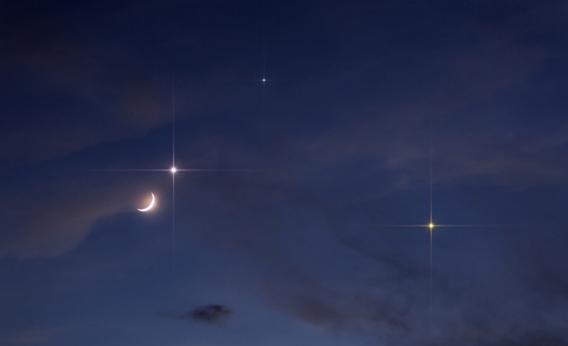Create a free profile to get unlimited access to exclusive videos, sweepstakes, and more!
See Five Naked-Eye Planets in the Sky at the Same Time!

If you get up very early over the next couple of weeks, there’s a treat waiting for you outside: All five naked-eye planets known since antiquity are visible in the dawn sky at once.
This is actually pretty cool, and it’s visible from anywhere in the world. Very generally, if you go outside well before dawn (5:30–6 a.m. local time) and look south (in the Northern Hemisphere; face north if you’re in the upside-down part of the world), you’ll see the planets lined up across the sky.
Mind you, that’s “very generally.” Here are some specifics:
In order from their apparent positions from the Sun in the sky, the planets are Mercury, Venus, Saturn, Mars, and Jupiter.* They scoot around a bit over the next few weeks, changing their positions and distances from each other, but stay in that order. Venus is the brightest by far, with Jupiter next. Saturn and Mars are about the same brightness as each other (compare them with the red supergiant star Antares which shines near Saturn), but Saturn will appear yellowish, while Mars will be rust-colored (because it’s rusty).
Probably the best time to go out to do this is around Feb. 1 or 2. That’s because Mercury is pretty close to the Sun right now and doesn’t clear the horizon until the sky gets light. During the first week of February it reaches what astronomers call greatest western elongation, when it’s farthest from the Sun in the sky before dawn. Even so, you’ll probably want binoculars to help you find it. It’s an irritating little planet sometimes and can hide in even thin clouds or twilight. Find Venus first, which should be pretty easy to spot, then look to its lower left for Mercury.
The planets all lie in a line because they orbit the Sun more or less in the same plane, called the ecliptic. The Earth’s in that plane, too (technically, the Earth’s orbit defines the ecliptic), so we see the other planets following that line across the sky. In the Northern Hemisphere, at my latitude of 40°, before dawn the ecliptic appears to angle away from the Sun to the upper right if you face east. But it’s different at different latitudes; near the equator that line is nearly vertical to the horizon, and in the Southern Hemisphere it tilts the other way, to the left if you face east before dawn. Folks near the equator get the best view of this event, then, because Mercury rises straight up from the horizon, so it’s up higher by the time the Sun rises and ruins the view. I talk about the motions of these objects in the sky in Episode 3 of Crash Course Astronomy:
The Moon moves around the sky far faster than the planets do and enters the scene near Jupiter on the morning of Jan. 27; over the next few days it’ll pass the planets one by one, becoming a thinner and thinner crescent as it does. It’ll be just 2° from Jupiter on Jan. 27, pretty close to Mars on the morning of Feb. 1, Saturn on Feb. 3, and then a difficult-to-spot fingernail Moon will be near Mercury and Venus on Feb. 6.
If you have a telescope, these are all fine objects to look at. Jupiter has its moons, Saturn displays its rings (and a moon or two), Venus will be nearly full, and Mercury will go from crescent to gibbous (a bit more than half full) over the next couple of weeks. Mars, however, won’t look like much; it’s nearly as far from Earth as it gets and will be very small even through a decent ‘scope. But don’t let me discourage you from taking a look! The color is still amazing to see. And of course our Moon is always a joy to see up close.
This view of the naked-eye planets isn’t common; the last time they were all visible at the same time was 10 years ago. They orbit the Sun at different speeds, like clocks all out of sync with each other, so sometimes you can see one or two together, sometimes more. This event really is a treat (and nothing to worry about doomsday-wise).
I’ll note that Pluto is very close to Mercury in the sky during this period, too. However, it’s far smaller and much, much, much farther away from us, so it’s a teeny bit fainter: Mercury is actually 400,000 brighter than Pluto in the sky right now.
And finally, of course there’s another naked-eye planet I’ve neglected to add to this list. But for that one, looking up won’t help. Look down. You’re standing on it! Bundle up, go out, look down, look up, and take in the view. It’s a good one.
*Technically, Uranus is just barely visible to the naked eye, sometimes, under good conditions. That’s why I added “known since antiquity” in the first paragraph, to ward off pedants.


























